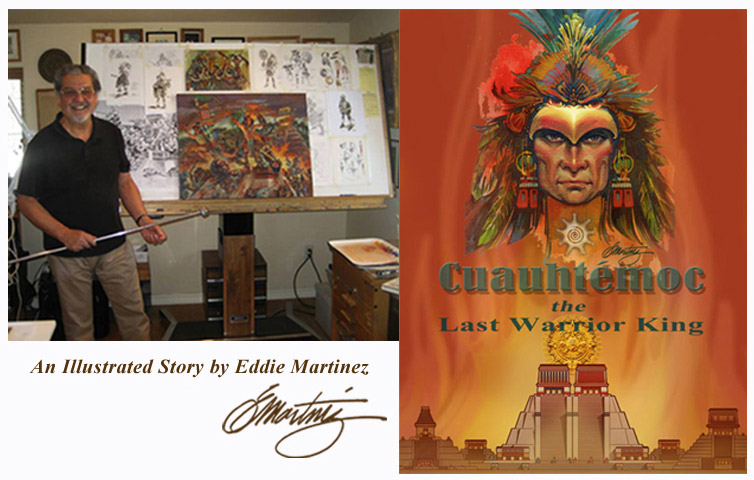Part 5 May 2015, Cádiz, Cortés assaulting
Tenochtitlán and Barcelona
By Eddie Martinez, Somos Primos article
ART, HISTORY & CULTURE:
Walking the streets of Spain while sketching and listening for voices from the past
Bv Eddie Martinez, edited and translated in Spanish by Viola Rodriguez Sadler

ARTE, HISTORIA & CULTURA:
Caminando por las calles de Espaha dibujando y escuchando las voces del pasado
Por Eddie Martinez, editado y traducido al espanol por Viola Rodriguez Sadler
From Al Andalus to Andalusia: In the 15th century, Andalusia reached its peak after the conquest of the kingdom of Granada by the Reyes Católicos or Catholic Monarchs, a title conferred on Ferdinand and Isabella by Pope Alexander VI in 1494. It was at that time that Christopher Columbus sailed from Cádiz to found Las Indias in the Americas.

De Al Andalus a Andalucía: En el siglo XV, Andalucía ha llegado a su apogeo después de la conquista del reino de Granada por los Reyes Católicos, un título otorgado a Fernando e Isabel por el Papa Alejandro VI en 1494. Fue en ese momento en que Cristóbal Colón zarpó de Cádiz a Las Indias en las Américas.
While our bus was driving past the fortress walls of Cádiz, I snapped a few pictures that include the two photos below. The bottom one is a distant photo of the Cádiz Spanish fort that is just across the bay of Playa de la Caleta. I wish our visit had included a tour of the fort-oh well, maybe next time.
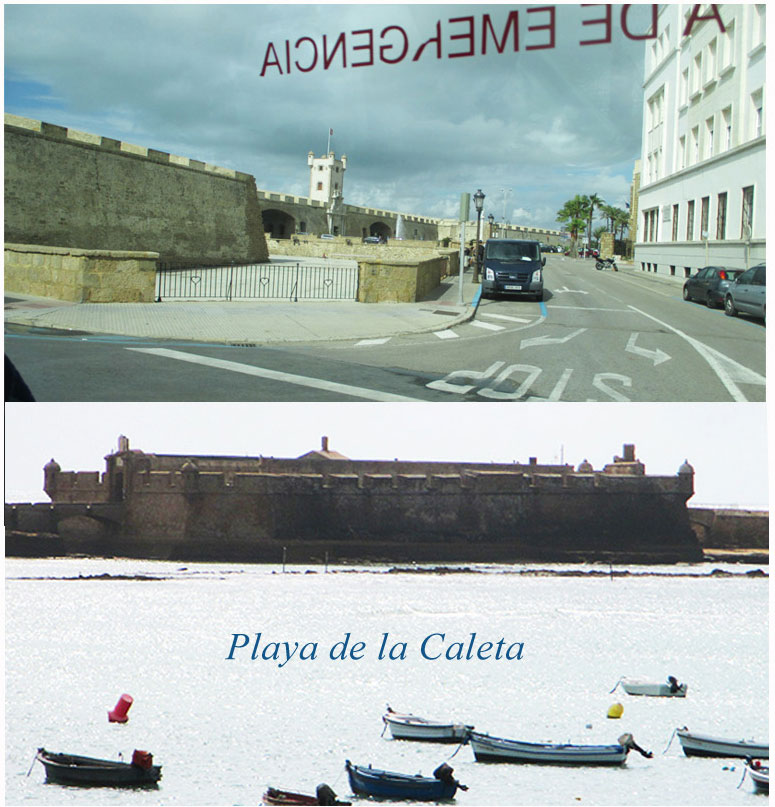
Mientras que nuestro autobus pasaba las paredes de la fortaleza de Cádiz, tomé algunas fotografías que incluyen las dos fotos de arriba. La segunda es una foto lejana del fuerte español de Cádiz que se encuentra enfrente de la Playa de la Caleta. Si sólo nos hubiera incluido una gira de la Fortaleza—ay, bueno, quizás la vez próxima.
This is an old Ficus Tree that stands in the somewhat center of Cádiz along the Avenida Dugue de Najera in the Costa de la Luz. Our tour guide said that Christopher Columbus’ son Diego Columbus, the 2nd Admiral and Governor of the Indies brought this tree from Española (modern day Dominican Republic), and planted it in the park. After researching Diego’s history, it appears to have happened sometime during 1515 when he visited Spain to defend his position as viceroy of the islands.
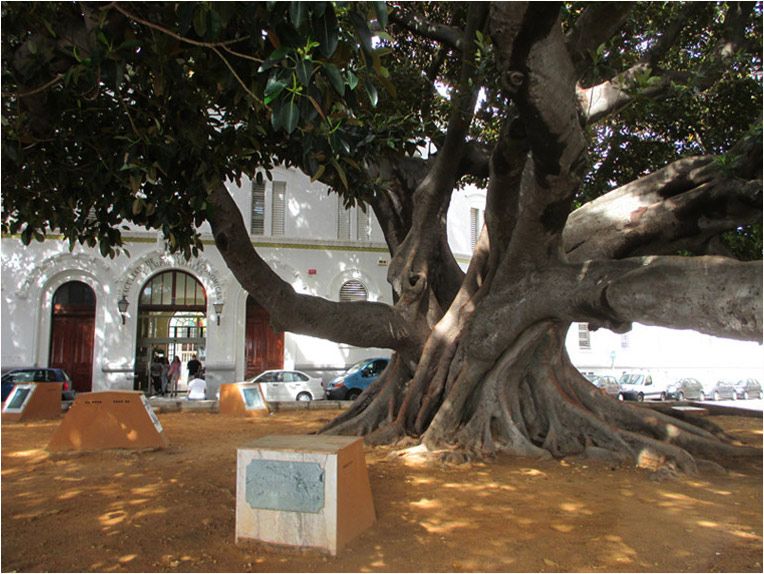
Este es un Arbol Ficus viejo que se encuentra en el centro de Cádiz un poco a lo largo de la Avenida Dugue de Nájera en la Costa de la Luz. Nuestro guía dice que el hijo de Cristóbal Colón, Diego Colón, el Segundo Almirante y Gobernador de las Indias trajo este árbol de Española (hoy República Dominicana), y lo plantó en el parque. Después de investigar la historia de Diego, parece haber ocurrido durante 1515 cuando visitó España para defender su posición como virrey de las islas.
DRAWING BOARD, from Cádiz to Tenochtitlán: In the process of developing my illustrated story, Cuauhtémoc, the Last Warrior King, I included the encounter of Hernán Cortés with king Moctezuma II as it was described by Cortés in his 2nd letter to king Charles V, dated October 30, 1520:
By a ship that I dispatched from this New Spain of your Sacred Majesty, on the sixteenth of July, in the year 1519, I transmitted to your Highness a very full and particular report of what had occurred from the time of my arrival in this country to that date; which I sent by the hands of Alonso Hernandez Puertocarrero and Francisco de Montejo, deputies of La Rica Villa de la Vera Cruz, the town I had founded in your Majesty's name.
[Later on the Iztapalapa causeway to Tenochtitlán] When we had passed the bridge, the Señor Muteczuma [Moctezuma II or Motecuhzoma] came out to receive us, attended by about two hundred nobles, all barefooted and dressed in livery, or a peculiar garb of fine cotton, richer than is usually worn.… At the time I advanced to speak to Muteczuma, I took off from myself a collar of pearls and glass diamonds, and put it around his neck.
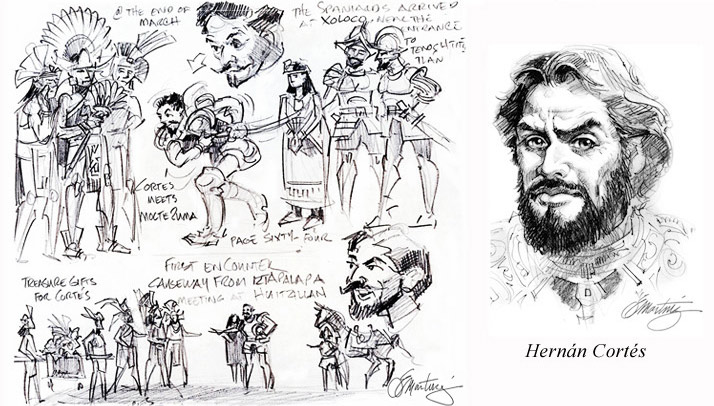
TABLERO DE DIBUJO, de Cádiz a Tenochtitlán: En el proceso de elaborar mi cuento ilustrado, Cuauhtémoc, el Ultimo Rey Guerrero, he incluido el encuentro de Hernán Cortés con el rey Moctezuma II, que fue descrita por Cortés en su 2ª carta al rey Carlos V, de fecha 30 de octubre de 1520:
En una nao que de esta Nueva España de vuestra sacra majestad despaché a diez y seis días de Julio del año de quinientos y diez y nueve, envié a vuestra Alteza muy larga y particular relación de las cosas hasta aquella sazón, después que yo a ella vine, en ella sucedidas. La cual relación llevaron Alonso Hernández Portocarrero y Francisco de Montejo, procuradores de la Rica Villa de la Vera Cruz, que yo en nombre de vuestra alteza fundé.
[Después en la calzada Iztapalapa a Tenochtitlán] Pasada esta Puente, nos salió a recibir aquel señor Mutezuma con hasta doscientos señores, todos descalzos y vestidos de otra librea o manera de ropa asimismo bien rica a su uso, y más que la de los otros … y al tiempo que yo llegué a hablar al dicho Mutezuma, me quité un collar que llevaba de margaritas y diamantes de vidrio y se lo eché al cuello…
A bird’s eye aerial view of the Grand City of Tenochtitlán – the Calmécac school and the Mexica Codex Library is located on the upper left corner of the city plaza.

Una vista de pájaro aérea de la gran ciudad de Tenochtitlán, la escuela Calmécac y la Biblioteca Mexica del Codex se encuentran en la esquina superior izquierda de la plaza de la ciudad.
Drawing Board: the beginning of my color illustration among my other different character studies. Scene, the Spanish priest is listening to the Mexica priest. On the left and right of them are the two-language translators who stand beside the priests, while a young student arranges the sacred books of Nahuatl Thought.
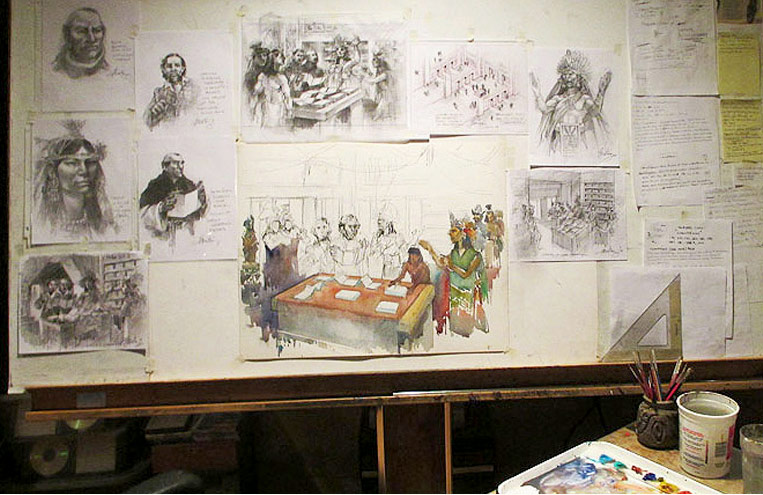
Tablero de Dibujo: el comienzo de mi ilustración en color entre mis diferentes estudios de las personalidades. Escena, el sacerdote Español está escuchando al sacerdote Mexica. A la izquierda y a la derecha de ellos se encuentran los dos traductores de lengua que están junto a los sacerdotes, mientras que un joven estudiante organiza los libros sagrados del Náhuatl.
Illustrated scene of the Tenochtitlán Calmécac library interior: The Head Master, Temachtiani, is speaking on the spoken word from the “Giver of Life,” saying something like, “Oh hear the voice of te-ixtlamach-tiani,” and then continues reciting a poem attributed to the famous Toltec king Nezahualcóyotl. Bartolomé de las Casas is listening while La Malinche translates the words of the speaker from Nahuatl to Maya for Gerónimo de Aguilar ears, who in turn, translates the words from Maya to Spanish for Bartolomé de las Casas. As the Spanish priest listens, he wonders whether the two translators may have corrupted the true meaning of the indigenous spiritual beliefs.
Ref: Aztec Thought and Culture by Miguel León-Portilla

Ilustra la escena del interior de la biblioteca de Calmécac en Tenochtitlán: el Maestro, Temachtiani, está hablando de la palabra del "Dador de Vida", diciendo algo así como: "Oh escuchen la voz de te-ixtlamach-tiani", y, a continuación, sigue recitando un poema atribuido al famoso Nezahualcóyotl rey Tolteca. Bartolomé de las Casas esta escuchando mientras La Malinche traduce las palabras del orador del náhuatl al Maya para las orejas de Gerónimo de Aguilar, que a su vez, traduce las palabras del Maya al español para Bartolomé de las Casas. Como el sacerdote español escucha, se pregunta si los dos traductores pueden haber dañado el verdadero significado de las creencias espirituales indígenas.
Ref: Aztec Thought and Culture by Miguel León-Portilla
Below are my drawing studies of the Governor of Cuba, Diego Velásquez de Cuéllar and the governor’s relative, Pánfilo de Narváez, who lost his eye in combat against Hernán Cortés in Vera Cruz.
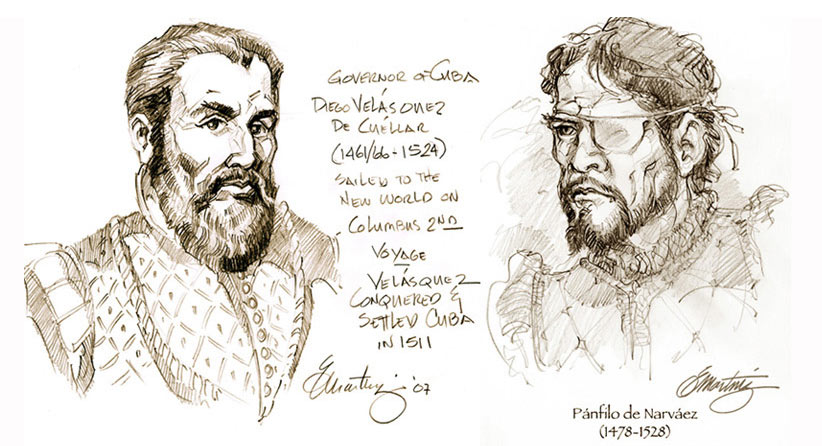
Arriba se presentan los estudios de mis dibujos del Gobernador de Cuba, Diego Velázquez de Cuéllar, y del pariente del gobernador, Pánfilo de Narváez, quien perdió su ojo en el combate contra Hernán Cortés en Vera Cruz.
April 20, 1520, San Juan de Ulúa - Pánfilo Narváez lands on the shores of Villa Rica de la Vera Cruz with 19 ships carrying 1,400 military troops with orders from the Governor of Cuba, Diego Velásquez de Cuéllar to arrest Hernán Cortés. Cortés received news of Narváez’s arrival and marched with 250 men back to the coast from Tenochtitlán. On May 27, Cortés and his men out maneuver his Spaniard enemies at Cempoala’s main pyramid temple where Naváez was wounded and taken prisoner. After the defeat, Diego Velázquez was ruined and died a broken man.


El 20 de Abril de 1520, San Juan de Ulúa—Pánfilo Narváez aterriza en la costa de Villa Rica de la Vera Cruz, con 19 buques que transportaban 1.400 militares con órdenes del Gobernador de Cuba, Diego Velázquez de Cuéllar, de detener a Hernán Cortés. Cortés recibió la noticia de la llegada de Narváez y se marchó con 250 hombres a la costa de Tenochtitlán. El 27 de mayo, Cortés y sus hombres se burlan de sus enemigos Españoles en el templo de la pirámide principal de Cempoala donde Naváez fue herido y hecho prisionero. Después de la derrota, Diego Velázquez fue arruinado y murió un hombre roto.
Villa Rica de la Vera Cruz: Juan Rodriguez Cabrillo was among Narváez’s captured military troops. When Hernán Cortés was questioning the prisoners, Cabrillo told Hernán Cortés that he wanted to join him and return with him to seek his fortune in the rich city of Tenochtitlán.
Note: Juan Rodriguez Cabrillo was born in Spain, probably Sevilla and did not know his exact age or have any family connections. Juan Rodriguez added “Cabrillo” to his name as a way to distinguish himself from many other Spaniards named Juan Rodriguez. Cabrillo’s early military education as a skilled crossbowman and experienced shipbuilder took place in Cuba.
Ref: Juan Rodriguez Cabrillo by Harry Kelsey

Villa Rica de la Vera Cruz: Juan Rodríguez Cabrillo estaba entre los militares capturados por Narváez. Cuando Hernán Cortés está poniendo en tela de juicio a las prisioneros, Cabrillo le dijo a Hernán Cortés que quería unirse a él y volver con él a buscar fortuna en la rica ciudad de Tenochtitlán.
Nota: Juan Rodríguez Cabrillo nació en España, probablemente en Sevilla, no sabía su edad exacta ni tienía algun parentesco. Juan Rodríguez agregó el “Cabrillo” a su nombre como una forma de distinguirse a sí mismo de muchos otros españoles llamados Juan Rodríguez. La educación militar de Cabrillo como un cualificado ballestero y experimentado constructor naval tuvo lugar en Cuba.
Ref: Juan Rodriguez Cabrillo de Harry Kelsey
After Hernán Cortés fought his way out of Tenochtitlán on the Noche Triste or “Night of Sorrows” on June 30, 1520 he was embittered and determined to return and to burn Tenochtitlán to the ground. In November of the same year, Cortés began his scheme to assault Tenochtitlán on the shores of Lake Texcoco by building a fleet of 13 brigantines with, *eighty-four horsemen, six-hundred-and fifty soldiers with swords and shields and many with lances, and one-hundred-and-ninety-four crossbowmen and musketeers to besiege the island city by water and land.
*The History of the Conquest of New Spain by Bernal Díaz del Castillo, Edited by Davíd Carrasco
Note: Earlier on July 1, 1519 in Villa de la Vera Cruz, Hernán Cortés had scuttled his ships, many of those ships were dismantled and important key parts of those ships were carried back to Texcoco by his men, among them were excellent ship builders.


Después que Hernán Cortés luchó su salida de Tenochtitlán en la Noche Triste el 30 de junio, 1520 quedó amargado y decidido a regresar y a quemar Tenochtitlán hasta el suelo. En noviembre del mismo año, Cortés inició su plan de asaltar Tenochtitlán en las orillas del lago Texcoco mediante la construcción de una flota de 13 bergantines con, * ochenta y cuatro de a caballo, seis cientos y cincuenta soldados de espada y rodela y muchos de lanzas, ciento noventa y cuatro ballesteros y escopeteros para sitiar la ciudad isleña por el agua y la tierra.
* Historia Verdadera de la Conquista de la Nueva España de Bernal Díaz del Castillo, editado por Davíd Carrasco
Nota: Antes, en el 1o de Julio de 1519 en la Villa de la Vera Cruz, Hernán Cortés había desarmado sus barcos, muchos de los buques fueron desmantelados y piezas importantes de los buques se llevaron a Texcoco por sus hombres, entre ellos habia constructores excelentes de buques.
This is a close-up of my putting the finishing touches on the warrior king, Cuauhtémoc leading his men in battle against the first Tenochtitlán assault by Pedro de Alvarado’s troops.

Aqui esta una mirada cerca que estoy dando los toques finales al Rey guerrero, Cuauhtémoc llevando sus hombres a la batalla contra el primer ataque de Tenochtitlán por las tropas de Pedro de Alvarado.
Captain Pedro de Alvarado leads his troops from Tacuba on the first battle of the Siege. The Spaniards advance on the causeway towards the heart of the city where Cuauhtémoc and his warriors charge head-on to clash with the Spaniards in a bloody hand-to-hand battle. 25 year-old warrior king, Cuauhtémoc is seen raising his sword as he rallies his warriors on. In the background, among the burning flames is Pedro de Alvarado on horseback slashing at attacking warriors with lances.

El Capitán Pedro de Alvarado conduce sus tropas de Tacuba en la primera batalla de Asedio. Los españoles avanzaron por la calzada hacia el corazón de la ciudad, donde Cuauhtémoc y sus guerreros chocan con los españoles en una sangrienta batalla mano a mano. Cuauhtémoc, el rey guerrero de veinticinco años de edad, se ve levantando su espada como elevando el espirito de sus guerreros. En el fondo, entre las llamas está Pedro de Alvarado a caballo acuchillando a los guerreros con lanzas que lo atacan.
The drawing on the bottom left is a scene of the last of the bloody hand-to-hand battles that was demoralizing to the defending Mexica warriors who were survivors of the deadly smallpox epidemics that was ravaging the people of Tenochtitlán along with those dying from starvation and thirst after the destruction of the aqueducts by the Spaniards. The drawing below, on the right depicts the final battle fought on August 13, 1521 when surviving wives, daughters and mothers took up the swords, shields and helmets of the fallen to become Mujeres de Guerra or “Women Warriors” defending Anáhuac to the very end.

El dibujo en la parte superior izquierda es una escena de la última batalla sangrienta de mano a mano que desmoraliza a los guerreros Mexicas que eran sobrevivientes de las epidemias de viruela mortales, que hacía estragos en el pueblo de Tenochtitlán junto con las personas que morían de hambre y sed después de la destrucción de los acueductos por los españoles. El dibujo que sigue a la derecha muestra la última batalla del 13 de agosto de 1521 cuando las esposas, hijas y madres sobrevivientes toman las espadas, rodelas y cascos de los caídos para convertirse en Mujeres de Guerra defendiendo Anáhuac hasta el final.
Tenochtitlán in Flames: This painting portrays Cuauhtémoc (Kwa-uh-TE-mok) the last warrior king and his wife, Tecuichpo, the daughter of Moctezuma II, as seen standing together watching their beloved city go up in flames while the frightened people are fleeing with their families to the waterfront to board waiting dugout canoes. On August 13. 1521, Cuauhtémoc and his family were captured in a canoe on the lake, an event that brought an end to Mexica rule and the loss of the Anáhuac civilization in the Valley of Mexico.
Note: In 1519, when Hernán Cortés arrived, the Tenochtitlán population was approximately 300,000 people living in the island city of Lake Texcoco.

Tenochtitlán en Llamas: Esta pintura retrata a Cuauhtémoc (Kwa-uh-TE-mok) el último rey guerrero y su esposa, Tecuichpo, la hija de Moctezuma II, como se ven juntos viendo su amada ciudad en llamas mientras que personas con sus familias huyen asustados hacia las canoas que los esperan junto al mar. El 13 de agosto de 1521, Cuauhtémoc y su familia fueron capturados en una canoa en el lago, un evento que trajo a fin el dominio de los Mexicas y la pérdida de la civilización Anáhuac en el Valle de México.
Nota: En 1519, cuando Hernán Cortés llegó, Tenochtitlán contaba con aproximadamente 300.000 personas que poblaban la ciudad isleña del Lago Texcoco.
Below are two photographs of Jessie and myself. The first in 1972, Madrid and the second in 2014, Andalusia and Barcelona: In our effort to better understand our ancestral Spanish roots.

Arriba se muestran dos fotografías de Jessie y yo. La primera en 1972, en Madrid y la segunda en 2014, Andalucía y Barcelona: En nuestro esfuerzo por mejor entender nuestras raíces ancestrales españolas.
Barcelona: My sketch book drawing of Guadí’s beautiful creations on the left and on the right, a photo of myself sitting with my sketch book in hand in Antoni Guadí’s Park Guell.

Barcelona: mi dibujo en mi cuaderno de bocetos de las creaciones hermosas de Gaudí a la izquierda y a la derecha, una foto de mí mismo sentado con mi cuaderno de bocetos en la mano en el Parque Güell de Antoni Gaudí.
Barcelona: On the left and right are two more sketches I made at Guadí’s Basilica of the Sagrada Familia. On the left is my sketch of the Crucifixion in the basilica’s high alters. On the right is my sketch of the Holy Family group in the Nativity facade of the Basilica.

Barcelona: a la izquierda y la derecha estan dos más bocetos que hice en la Basílica de la Sagrada Familia de Gaudí. A la izquierda está mi boceto de la Crucifixión en el altar mayor de la basílica. A la derecha esta mi boceto de la Sagrada Familia en la fachada del Nacimiento de la Basílica.
Part 5 is my final article on my research trip to Andalusia to better understand from a Spanish 16th century point of view the historical events that lead up to and the events during the Spanish besiege and occupation of island city of Tenochtitlán in the Valley of Mexico. I’m now back at home in Colorado, writing and illustrating my story, “Cuauhtémoc: the Last Warrior King,” with a broader understanding of the human and historical events that took place in the Old World and the New World.

Este quinto artículo es el último de mi viaje de estudios a Andalucía para una mejor comprensión del punto de vista Español del siglo XVI de los acontecimientos históricos en los que llevan a los hechos ocurridos durante el asedio y la ocupación Española de la ciudad isleña de Tenochtitlán en el Valle de México. Ahora estoy en casa en Colorado, escribiendo e ilustrando mi historia “Cuauhtémoc: el Ultimo Rey Guerrero,” con un mayor entendimiento de lo humano y los acontecimientos históricos que tomaron lugar en el Viejo Mundo y el Nuevo Mundo.
Acknowledgement: I am grateful for the Spanish translations by my friend, Viola Rodriguez Sadler. Thank you for your unselfish support and thank you Mimi Lozano for giving me the opportunity to post my articles on Somos Primos Online.
Reconocimiento: Estoy agradecido por la traducción al Español por mi amiga, Viola Rodríguez Sadler. Gracias por su apoyo desinteresado y gracias a Mimi Lozano, por darme la oportunidad de publicar mis artículos en Somos Primos Online.
Cuauhtémoc, the Last Warrior King
